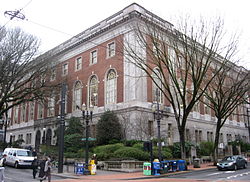Central Library (Portland, Oregon)
Central Building, Public Library | |
Portland Historic Landmark[2] | |
 | |
| Location | 801 SW 10th Avenue Portland, Oregon 97205 |
|---|---|
| Coordinates | 45°31′09″N 122°41′00″W / 45.519140°N 122.683202°W |
| Area | 1 acre (0.40 ha) |
| Built | 1913 |
| Architect | A. E. Doyle |
| Architectural style | Georgian style |
| NRHP reference No. | 79002129[1] |
| Added to NRHP | June 11, 1979 |
The Central Library is a three-story public library branch in the downtown core of Portland, Oregon, United States. Opened in 1913, it serves as the main branch of the Multnomah County Library system. In 1979, the Georgian style building was added to the National Register of Historic Places as the Central Building, Public Library. The library underwent major structural and interior renovations in the mid 1990s.
History

The Library Association of Portland was formed in 1864.[4] After going through several locations during the first half-century of existence, the library board decided on a new large main branch for downtown Portland in 1911.[5] The building was designed by architect A. E. Doyle, and opened on September 6, 1913.[6] It was one of the first libraries in the United States to feature an open plan design of the interior.[7] Construction on the building lasted for two years and cost $480,000 to complete.[6] Librarian Mary Frances Isom provided input on the design.[8]
The Central Library was listed on the National Register of Historic Places as the Central Building, Public Library on June 11, 1979.[9] On July 1, 1990, the private Library Association of Portland officially transferred ownership of the library to Multnomah County.[6] From 1902 until that date, the association owned the collections and buildings, but the operations were paid for by the local governments.[6] From 1994 to 1997, the Central Library underwent an extensive renovation. The entire roof of the building was removed and completely rebuilt, while much of the interior was remodeled and restored.[7] During the renovation, the library collection was moved to the nearby Fifth Avenue Building (the former State Office Building). Library patrons still had access to the collection during the reconstruction.[10]
Details
Architecturally, the building was designed in the Georgian style.[11] The main staircase at the library has a total of 92 steps.[12] Artwork at the location includes the "Tree of Knowledge" by Dana Louis.[13] The exterior walls are covered with Wilkinson Sandstone.[8] Interior details include extensive use of marble and wood.[14] The branch contains 125,000 square feet (11,600 m2) of space spread over the three floors.[15]
The branch is home to the Beverly Cleary Children's Library and the Henry Failing Art and Music Library.[14] Other features include the Sterling Room for Writers, the Collins Gallery on the third floor, and the John Wilson Room.[14] The first floor houses the U.S. Bank Room, a small conference room available for public use.[16] The library's collections weigh more than 875 tons and take up 17 miles (27 km) of shelf space.[16] A total of 130 computer terminals are available to the public.[16]
References
- ^ "National Register Information System". National Register of Historic Places. National Park Service. March 13, 2009.
- ^ Portland Historic Landmarks Commission (July 2010), Historic Landmarks -- Portland, Oregon (XLS), retrieved October 31, 2013.
- ^ Library of Congress record notes
- ^ Corning, Howard M. (1989) Dictionary of Oregon History. Binfords & Mort Publishing. p. 147–148.
- ^ Gunselman, Cheryl. Pioneering Free Library Service for the City, 1864–1902: The Library Association of Portland and the Portland Public Library. Oregon Historical Quarterly, September 22, 2002. Pg. 320 Vol. 103 No. 3 ISSN 0030-4727
- ^ a b c d About the library: History. Multnomah County Library. Retrieved on March 13, 2008.
- ^ a b Gragg, Randy. Recycling the Armory. The Oregonian, September 24, 2006.
- ^ a b Norman, James B. (1991). Portland's Architectural Heritage: National Register Properties of the Portland Metropolitan Area. Portland, Or: Oregon Historical Society Press. p. 124.
- ^ "Oregon National Register List" (PDF). Oregon State Parks and Recreation Department. July 16, 2007. Archived from the original (PDF) on 2011-06-09. Retrieved 2008-03-10.
- ^ Nokes, R. Gregory. Seeing past the slump. The Oregonian, November 11, 2001.
- ^ Gragg, Randy. The Dance of the White Elephant. The Oregonian, September 15, 2002.
- ^ Haight, Abby. Explorer chronicles city's thigh-busting public stairways. The Oregonian, October 12, 2006.
- ^ Graff, Randy. Collecting on the cheap. The Oregonian, June 27, 1997.
- ^ a b c Dresbeck, Rachel. (2007). Insiders' Guide to Portland, Oregon: Including the Metro Area and Vancouver, Washington. Insiders' Guide Series. Guilford, Conn: Insiders' Guide. p. 141. ISBN 0-7627-4189-9. Retrieved on March 13, 2008.
- ^ Carmin, Jim. "Central Library (Multnomah County Library)". Oregon Encyclopedia. Retrieved March 12, 2022.
- ^ a b c Central Library. Multnomah County Library. Retrieved on March 13, 2008.
Further reading
- Ritz, Richard E. (2000). Central Library: Portland's Crown Jewel. Library Foundation. ISBN 0-9674860-0-9.
External links
- Library buildings completed in 1913
- Libraries in Portland, Oregon
- Multnomah County Library
- National Register of Historic Places in Portland, Oregon
- 1913 establishments in Oregon
- A. E. Doyle buildings
- Libraries established in 1913
- Libraries on the National Register of Historic Places in Oregon
- Southwest Portland, Oregon
- Portland Historic Landmarks



